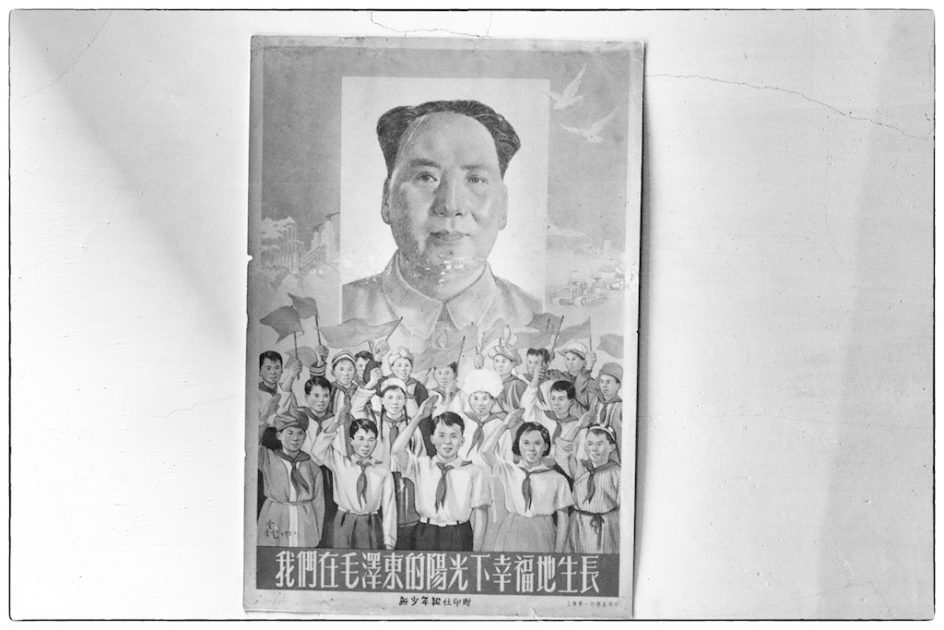
During the Qing Dynasty in China (1644-1911), a prosperous merchant surnamed Hunag built an imposing sixteen bedroom house in China’s southeaster region, calling his home Yin Yu Tang. The Peabody-Essex Museum spent millions of dollars moving the house from China to the museum in Salem, Mass. where it has been lovingly re-assembled and draws visitors from all over the world.
Maria and I saw this house on Sunday, it was fascinating to see, I was especially struck by the posters of Mao and the Red Army that were up in various rooms throughout the house. There are at least three historical figures that have fascinated me my whole life – Thomas Paine, Mao and Winston Churchill. I read everything i can find about them.
Mao is in a category all by himself in many ways. Historians say he murdered more people in his lifetime than either Hitler or Stalin, the other two well-documented monsters of the last century.
He also broke the power of the rich clans who controlled much of the land, brought women into education and politics, advocated near universal health care for peasants, and set the stage for the amazing transformation of China after his death.
Reading my history books has always led me to believe that political leaders and despots live far too long, they often start out with idealistic and noble arteries and so often turn to pure evil, the older they get, the more murderous and frightening they can become.
Mao is till revered by most Chinese people, who worship him as a savior and liberator. His pull on the imagination of people everywhere is still strong.
I have never really figured him out, or read anything that helped me to completely figure him out. I think he is unknowable to the outside world.
Some of his own early writings are powerful and revealing. So I was startled to see him hanging on the bedroom walls in this meticulously restored rich man’s house in a museum in Salem, Mass.
I wanted to say hello, and ask him a few questions, and he triggered a flood of memory.
I once worked for a brilliant journalist named Harrison Salisbury when I got my first job in journalism as a copy boy for the New York Times. More than any person I have ever known, I wanted to be Salisbury, a fearless, elegant and aloof reporter from a time when journalists did much more than shout at one another on cable news, or troll Twitter for story ideas.
The sad thing is that most people living today will never know what they are missing.
Salisbury was the first American correspondent in Moscow after World War II and he walked with Mao on the Long March across China that led to the great revolution and changed the course of world history. If Salisbury even noticed me, I would be surprised. I got him coffee and ferried his copy to the news desk, when he typed a page, he would simply hold it up in the air, and God help me or any other copy boy if he had to wait more than 10 seconds for me to come get it.
I wanted to be him so badly I still sometimes cry when I think of it, his reporting and intellect were both unlike anything I had ever seen, then or now, and I thought of him when I saw Mao’s posters in the Yin Yu Tang House.
I rushed online this morning and ordered his great book ‘The Long March” about Mao’s famed march to revolutionary triumph and glory. I lost my dog-eared copy years ago and I can’t wait to read it again. Salisbury also wrote perhaps the greatest account of the horrible siege of Stalingrad towards the end of World War II.
Salisbury was a major reason I left the New York Times to take a job as a reporter at the Atlantic City Press, where I felt so much more comfortable. I didn’t belong at the Times. Later on, I realized that one reason I left the paper was that I knew I could never be him or anyone like him. And I was right, I’m not.
I’m glad I didn’t waste my life trying.
It was a fascinating convergence of things for me in Salem, a place of spirits – memories, yearnings, history and a kind of curiosity that can never be fulfilled.

You wired for HARRISON SALISBURY ??? He’s one of my heroes !! Wow
I got him coffee, he was a great journalist, for sure…
Wow….just to be in the same room….I was at the New York City Ballet once with my mother. I had the aisle seat and JEROME ROBBINS came and sat on the step right next to me…he had a legal pad and a pencil and as he watched the performance that pencil was moving very quickly over the page…I thought the performance was perfection and maybe he did too, I wish I had asked him. There are some very brave people these days doing important journalism…we will know their names some day.